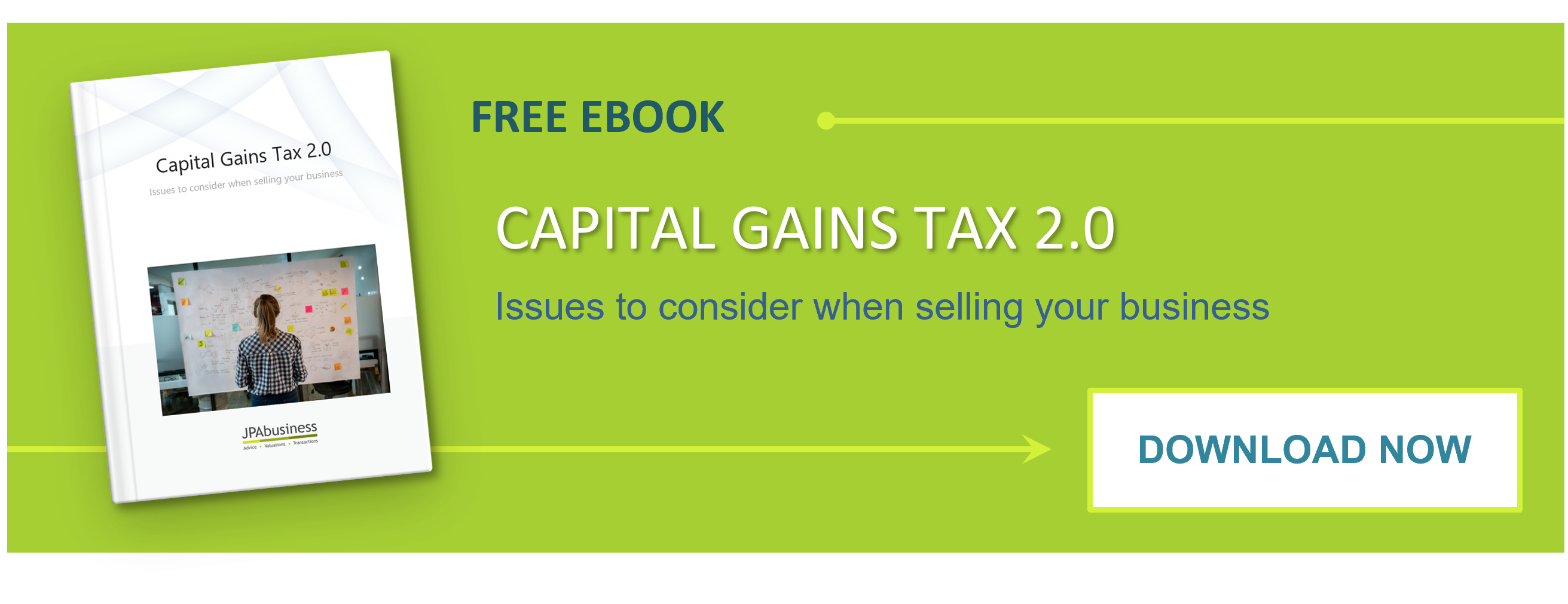
In 2014 we published an eBook titled Capital Gains Tax – Issues to consider when selling a small to mid-sized business. This eBook drew on extensive experience, including that of our guest contributor Michael Pisani, partner at Chapman Eastway, and remains one of our most popular publications to date.
Given the far-reaching scope of Capital Gains Tax (CGT) and the ever-evolving nature of taxation laws, in 2017 we released Capital Gains Tax 2.0 – Issues to consider when selling your business. The new eBook did not replace the original, but instead complemented it.
Over the past few months, the JPAbusiness team has been reviewing and updating the information in both eBooks, to reflect the most recent changes in Australian tax policy.
The following blog is an excerpt from our updated eBook: Capital Gains Tax 2.0 – Issues to consider when selling your business.
CGT basics
Capital Gains Tax (CGT) is the tax payable on the sale of capital assets. Capital assets are generally assets which have a useful life of more than 12 months, however there are exceptions to this rule. Capital assets include those relating to a going concern business and also partial assets that may have been associated with a business (e.g. plant and equipment).
Capital gain: When a capital asset is sold, the sale price less the cost base is the capital gain. This only applies to assets acquired after 20 September 1985 (with some exceptions).
Cost base: As defined by the Australian Tax Office (ATO), the cost base consists of the amount originally paid for an asset as well as costs associated with acquiring, holding and disposing of the asset. Such costs may include:
- rates on investment properties
- brokerage fees on purchase and sale
- costs of advertising to sell the asset.
However, if these costs are expensed (i.e. have previously been a tax deduction) prior to a CGT sale, they do not form part of the cost base.
Capital gain = Sale price – Cost base*
* In the case of a capital loss, the cost base is calculated differently
Capital Gains Tax: The tax payable on a capital gain. This is based on an individual’s marginal tax rate.
Capital gains tax = Capital gain x Marginal tax rate
However...
There are a range of capital gains concessions which may reduce the taxable amount of the capital gain. In relation to small to medium businesses, the main concessions to consider are:
- General CGT discount: For assets held for more than 12 months, the capital gain that is taxable is reduced by 50%;
- Small Business CGT Concessions: A range of concessions are available for businesses which meet the associated small business criteria and these will be discussed in detail later on. Your eligibility can have a large impact on the ultimate tax outcome.
Selling a business – Asset sale versus Share sale
When selling a business, you can sell the shares in the business (i.e. ordinary share capital in the company entity that owns the business) or sell the assets of the business.
As a general rule of thumb, purchasers tend to prefer to buy business assets as opposed to shares in the ownership entity, because they take on less risk associated with the history of the entity. However, this can depend on the size and complexity of the business transaction.
These two methods may lead to quite different tax results.
Here’s an example: XYZ Pty Limited is 100% owned by Husband and Wife. The company conducts a retail business.
| The key assets in XYZ Pty Ltd are: | $ | ||||
| Stock at cost | 2,000,000 | ||||
| Cash | 1,000,000 | ||||
| Plant and equipment (P&E) >12 months old written down value (WDV) | 1,500,000 | ||||
| Internally generated goodwill | 2,000,000 | ||||
| Total asset value | 6,500,000 | ||||
For our example, we’re going to assume:
- Husband and Wife are both in the top marginal rate of income tax (45%)
- Husband and Wife purchased shares in the company for $100,000
16 years ago.
Scenario 1: Husband and Wife sell shares in XYZ Pty Limited for $6,500,000
| Net gain calculation | ||||
| $ | $ | |||
| Sale price | 6,500,000 | |||
| Cost base | 100,000 | |||
| Capital gain | 6,400,000 | |||
| General CGT discount of 50% | (3,200,000) | |||
| Taxable gain | 3,200,000 | |||
| Tax on taxable gain @ 45% | 1,440,000 | |||
| Net gain | 5,060,000 | |||
Scenario 2: An extraction or sale of business assets from the company, XYZ Pty Limited
Rather than selling the shares in the company, let’s say XYZ Pty Ltd sold the business assets out of the company.
The assets sold include stock, P&E and internally generated goodwill. Cash is specifically excluded from this sale and therefore the price paid for the assets is $5,500,000.
| Net gain calculation | |||
| $ | |||
| Sale price | 5,500,000 | ||
| Asset value | 3,500,000 | ||
| Gain on sale (goodwill) | 2,000,000 | We assume stock and P&E are sold at written down value and therefore do not give rise to taxable income | |
| Tax on gain | 550,000 | At the company tax rate of 27.5% | |
| Cash receipt from sale | 4,950,000 | Sale price less tax on gain | |
| Pre-existing cash in business | 1,000,000 | ||
| Total cash in business | 5,950,000 | ||
| Dividend paid to Husband and Wife | 5,950,000 | This releases cash from the company and places it in the hands of Husband and Wife | |
| Franking credit* | 2,256,865 | Assuming fully franked dividend – applicable gross-up rate is 2.6364, calculated as (100% - 27.5%) / 27.5% | |
| Total taxable dividend | 8,206,865 | Husband and Wife are liable to pay tax on the dividend and franking credit | |
| Tax payable @ 45% | 3,693,089 | ||
| Less: franking credit | 2,256,865 | ||
| Total tax payable | 1,436,224 | ||
| Net gain | 4,513,776 | Dividend paid to Husband and Wife less total tax payable | |
*Franking credits are a mechanism in the Australian taxation system which avoids ‘double taxation’ by recognising the tax a company has already paid when assessing an individual’s income tax liability associated with dividend payments from Australian companies. Basically, a franked dividend comes attached with a franking credit – this is the amount of tax the company has already paid on the dividend being paid. The franking credit forms part of the taxable income associated with a dividend, hence why it is part of the tax liability calculation above. However, as the franking credit represents tax already paid, the calculated tax liability is then reduced by the value of the franking credit. In this scenario we have assumed the dividend is fully franked, meaning the whole dividend carries a franking credit. Dividends can be partially franked, where only part of the dividend is franked and the remainder is unfranked.
Why is the general CGT discount applicable to Scenario 1 but not Scenario 2?
As per ATO guidelines, the general CGT discount:
- allows you to reduce your capital gain by:
- 50% for individuals (including partners in partnerships) and trusts
- 33¹⁄3% for complying super funds
- is not available to companies
- has more rules which apply to beneficiaries entitled to a share of a trust capital gain.
In Scenario 1 Husband and Wife receive a capital gain on shares they own as individuals, thus upon sale of the shares in XYZ they are eligible for the general CGT discount of 50%.
However in Scenario 2, the assets are sold from XYZ – a company – to a third party. As the above states, companies are not eligible for the general CGT discount. Therefore, even though the assets may have been held for more than 12 months, the gain is not eligible for the general CGT discount because the assets are being sold by a company.
Had the ownership structure in Scenario 2 been a partnership or trust, then the asset sale would likely be eligible for the 50% general CGT discount, assuming the 12-month ownership threshold had also been met.
Summary:
| Scenario | Tax payable | Net gain |
| $ | $ | |
| 1 | 1,440,000 | 5,060,000 |
| 2 | 1,436,224 | 4,513,776 |
| Variance | 3,776 | 546,224 |
As you can see, the net outcome for Husband and Wife is $546,224 more favourable under a share sale than an asset sale. This equates to about 8.4% of the sale price.
This example highlights the importance of understanding the difference in net outcome which can arise from a Share sale compared to an Asset sale.
As mentioned earlier, purchasers tend to purchase business assets rather than shares in a company, creating a conflict with the tax advantage the vendor can gain from a share sale. Therefore, negotiations need to be well planned to ensure you obtain the most favourable after-tax outcome.
This example doesn’t factor in the possibility of accessing the Small Business CGT Concessions. These concessions could potentially reduce the tax payable in both scenarios and, again, could change the after-tax result.
We’ll look at the Small Business CGT Concessions, and their implications for Husband and Wife, in future blogs.
 What about earnouts?
What about earnouts?
An earnout is a payment to the vendor which is contingent on the performance of the business or related factors after the sale has occurred.
Often the vendor continues to work in the business during the earnout period and the potential earnout is an incentive for them to maintain or enhance the performance of the business.
Earnouts are a reasonably common component of a business sale. They can be beneficial for both vendor and buyer:
- The buyer is protected from overpaying on a business which fails to performs post sale
- Should the business perform at or above expectations after the sale, the vendor has the opportunity to benefit from this performance.
The tax treatment of earnouts was changed in February 2016. A summary of how earnout payments are now treated under tax law (if qualified as a look-through earnout right*) is as follows:
- At the time of sale, earnouts are not valued for taxation purposes.
- Earnouts do not give rise to a tax liability until the earnout is received (i.e. a tax liability is not created until the vendor receives an earnout payment).
- When an earnout is received, it is taxed under Capital Gains Tax rules.
- When the earnout is received, it is taxed by submitting an amended income tax return for the period in which the asset was sold – this will give rise to a Capital Gains Tax liability in association with the earnout.
- A future financial benefit received or provided under a look-through earnout right may affect your eligibility for some CGT concessions that are discussed in Chapter 2 of the eBook. It may also impact on the time allowed for you to take certain actions to satisfy the eligibility requirements.
*A look-through earnout right is a right to future financial benefits which are not reasonably ascertainable at the time the right is created. The right must be created under an arrangement involving the disposal of a CGT asset that is an ‘active asset’ of the seller, and the financial benefits under the right must be contingent on and reasonably related to the future economic performance of the asset (or a related business).
The information contained in this blog is general in nature and should not be taken as personal, professional or taxation advice. You ought to make your own inquiries and seek independent, professional advice before taking action or relying on any information in this blog. As Capital Gains Tax legislation is subject to change, we cannot guarantee the timeliness of the information provided.
Last updated November 2019.
 James Price has over 30 years' experience in providing strategic, commercial and financial advice to Australian and international business clients. James' blogs provide business advice for aspiring and current small to mid-sized business owners, operators and managers.
James Price has over 30 years' experience in providing strategic, commercial and financial advice to Australian and international business clients. James' blogs provide business advice for aspiring and current small to mid-sized business owners, operators and managers.

